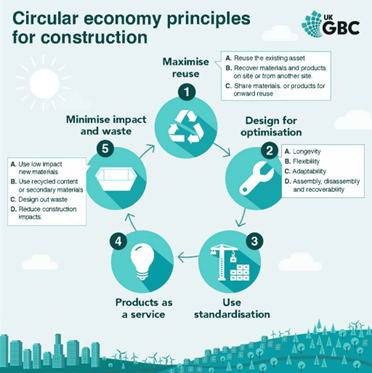The circular economy priorities the reuse of materials in order to prevent the exacerbation of natural resources and the quantity of useable materials that end up in landfill. It can be classed as an economic model that builds system health by decoupling economic activity from the consumption of finite resources. Lifestyle and global demographic changes are increasing the demand for these finite resources globally, many of which are becoming scarcer and more difficult to extract.
 ‘A circular economy could reduce global CO2 emissions from building materials by 38% in 2050’.
‘A circular economy could reduce global CO2 emissions from building materials by 38% in 2050’.
Circular Economy Principles:
The fundamental principles are placing more importance on nature regeneration, sustainable resource management, and carbon reduction. Also:
- Maximise reuse (including refurbish and repurpose)
- Design buildings for optimisation
- Use standardisation
- Products as a service
- Minimise impact and waste
Built Environment:
The built environment includes buildings, infrastructure, roads and other human-made features; this has resulted in nearly 50% of materials being extracted globally on an annual basis, which contributes significantly to greenhouse gas emissions. The way in which our environment is designed, constructed and eventually demolished is established in the linear take-make-waste economy. The built environment is under tremendous pressure to minimise its impact by adapting to a circular approach, which reduces the sectors environmental footprint and rising costs.
By implementing circular economy principles, we can still create urban areas that are designed and constructed sustainably by reducing greenhouse gas emissions. The sector will also become more resilient to price volatility and supply chain disruptions of raw materials. This can be achieved by implementing new technologies and adapting business models, as well as realising the potential value from existing assets, and stopping these resources and building materials from becoming waste. A circular economy approach will have an improved return on investment for investors and construction clients. Redesigning the current sector can be accomplished by city governments, developers, asset managers, and construction product manufacturers, who play vital roles across the value chain in the built environment sector.
How Can WPSCC Help?
At WPSCC, we provide a wide range of compliance services covering:
- BREEAM/Construction Consultancy
- Environmental Consultancy
- Planning Services
- Training and Development Services
We specialise in waste management; we provide forecasts in waste production, document waste minimisation practices, record all waste arisings in concordance with the Waste Duty of Care (DOC) compliance, and implement the waste hierarchy to identify reuse/recycle/disposal performance.
WPSCC have developed a software tool called SitePlan that enables clients to be self-sufficient and manage their own waste and environmental data.
Call us NOW on 01604 859961, or email [email protected] to ask our advice / guidance.
References:


